Holi Festival
As the Holi festival celebration in India brings a lot of happiness, joy and colors to everyone’s life to make the life of people colorful, it is commonly called as the “Festival of Colors”. As it brings the unity and love among people, it is also called as the “Festival of Love”. It is a traditional and cultural Hindu festival being celebrated from the ancient time by our old generations and followed every year by the new generations.
It is a festival of love and colors celebrated annually by the religious Hindu people with great joy and enthusiasm. It is a festival of mind refreshment which not only refreshes the mind of people but also their relations. It is the festival which people celebrate by getting together with their family members and relative to distribute love and affection to each other as well as strengthen their relationship. It is a festival of bonding a relation which binds the people in one rope by removing their old misbehavior.
At this day, people use red color or red abir which is not only a red color but it is the symbol of love and affection to each other. Really, it makes the people colorful not only from outside but it fulls their soul and life with multicolor. It is not good to say it an ordinary festival as it colors the uncolored people. It brings a break to the normal routine of the hectic life of the people.
It is celebrated everywhere by the Hindus of an Indian origin however, it is mainly observed by the people in India and Nepal. It is a ritual festival in which people bonfire the Holika by getting together, singing songs and dance in the myth to burn all the bad habits and bad power with the Holika and get new energy and good habits for their life achievements. Next morning brings a lot of happiness to them which they express by coloring and gaming whole day.
They use water guns and balloons to play holi in the open street, parks and buildings. Some musical instruments are used to sing songs and dance. They spend their whole day by coloring, singing, dancing, eating delicious things, drinking, hugging to each other, meeting friends at their home and lots of activities.
Holika Dahan | Holi Wishes SMS | Essay on Holi
Holi 2019
Holi festival 2019 will be celebrated with great enthusiasm by the people in India as well as abroad on 21st of March, at Thursday.
When is Holi Celebrated
According to the Hindu calendar, holi festival is celebrated on the annual basis in the month of March (or occasionally in the month of February) in the full moon, Phalguna Purnima. This festival celebration indicates the triumph of goodness over evil power. It is the festival when people meet each other, play, laugh, forget problems and forgive each other as well as renovate their relationships.
It is celebrated with an immense pleasure in the start of the summer season and end of the winter season to the last day of the full moon of the lunar month, Phalguna. It is the festival of lots of fun and frolic activities which bind people at one place. Everyone has a big smile on their face and wear new clothes to show their happiness.
Why is Holi Celebrated
There are many reasons to celebrate the holi festival every year. It is the grand celebration of colors, delicious foods, unity and love. Traditionally, it is celebrated to get success over the evil power or badness of goodness. It is named as “Phagwah”, as it is celebrated in the Hindi month, Phalgun.
Holi word is generated from the word “hola” which means to offer puja to the God for getting new and good harvest. Holika Dahan at the festival of holi indicates that people who admire God shall be saved like mythical character Prahlad whereas who fed up the people of God shall be punished by Him a day like mythical character Holika.
There are many historical significance and legends (in the Puranic story of India) of celebrating the holi festival. It is one of the oldest Hindu festivals which have been getting celebrated for years. There are various remnants related to the holi celebration has been found on the ancient Indian temples walls. There are existing varieties of medieval paintings of 16th century in the Ahmednagar paintings and Mewar paintings which represents the holi celebrations during ancient time.
Holi celebrations vary from states to states such as in many states of the country, holi festival is celebrated for the three consecutive whereas in various other states it is one day festival. People celebrate first day of the holi (known as full moon day or Holi Purnima) by showering colored powder on other members of the home. They start ceremony by putting some colored powder and brass pot full of water in a thali. Second day of the festival is called as the “Puno” means main day of the festival when people bonfire the Holika according to the Muhurt.
This process is done to commemorate the ancient history of Holika and Prahlad in myth of triumph of goodness over badness. Third day festival is called by the name “Parva” means last day of the festival during which people come out of their home, hug each other, apply colored powder on the forehead, play color, dance, sings, meet each other, eat delicious recipes and so many activities. Holi is popularly called as “Lath Mar Holi” in the Uttar Pradesh, “Phagwah” or “Deol” in the Assam, “Dol Purnima” in the Bengal, “Dol jatra” in the West Bengal, “Fagu” in the Nepal and etc according to the customs and traditions.
Holi in Mathura and Vrindavan
The holi festival is a very famous festival of the Mathura and Vrindavan. Some highly enthusiastic people living in other regions of India gather at Mathura and Vrindavan especially to see the holi celebration. Mathura and Vrindavan is the great land where Lord Krishna took birth and do lots of activities. Holi is one of them. According to the history, it is believed that holi festival celebration was started from the time of Radha and Krishna. Both of the places are very famous for the holi celebration in Radha and Krishna style.
People in Mathura celebrate holi with lots of fun-frolic activities. Holi festival is of great significance of love and devotion for them where lots of romance is found to see and experience. A whole week celebration takes place with a huge crowd of people from every corner of India. There is a Bakai-Bihari Temple in the Vrindavan where a grand celebration takes place. Another place to celebrate holi near Mathura is Gulal-Kund in Braj, it is a lake near to the Govardhan mountain. A Krishna-Lila drama is organised here at big level to enjoy the holi festival.
Holi in Barsana or Lathmar Holi
People in Barsana celebrate Lath mar Holi every year which is very interesting. People from nearest regions come to see the holi celebration in Barsana and Nandgaon. Barsana is a town in the Mathura district in the Uttar Pradesh state. Lath mar holi is a holi celebration with stick in which women hit men with stick. It is considered that, little Krishna came to Barsana to see Radha on the day of holi where he teased her and her friends and in return he too was chased by them. Since then, people in Barsana and Nandgaon celebrate holi using sticks which is called as Lath mar holi.
Thousands of people from the nearby regions get together to celebrate the lath mar holi at the Radha Rani temple in Barsana. They also sing Holi Songs and narrate Sri Radhey and Sri Krishna. Gops or shepherds of Nandgaon play holi with gopis or shepherdesses of Barsana and gops of Barsana plays holi with gopis of Nandgaon every year. Some simulative songs are sung by the men to get attention of women; in turn women get offensive and beat men with sticks. There is a tradition of drinking thandai as a cold drink or Bhang.
History and Significance of Holi Festival
Holi festival is getting celebrated from the very ancient time because of its cultural and traditional beliefs. It has been mentioned in the Holy books of India such as Puranas, Dasakumara Charita, Sanskrit drama, Ratnavali and so many. At this ritual festival of Holi people started making a heap of the wood and other combustible materials for the Holika Dahan ceremony in the roads, parks, community centers, nearby areas of temples and etc. People started doing home preparations as well such as cleaning, washing, making gujiya, sweets, mathri, malpuas, chips and so many things.
Holi is a big festival for the Hindus all over the India which exists from several centuries before the Christ. Earlier the holi festival was celebrated by the married women by worshipping the full moon for the well being of their family. According to the ancient Indian mythology, there are many legends behind celebrating this festival.
Holi is a cultural, religious and traditional festival for the Hindus in the country. Holi word is originated from the word “Holika”. Holi festival is specially celebrated by the people in India due to the great reason behind.
According to the region wise celebration of the holi, this festival has its own mythological significance including cultural, religious, biological and etc significance. Mythological significance of the holi festival belongs to the historical legends associated with the festival.
Mythological Significance
- First mythological significance of the holi celebration is the legend of Prahlad, Holika and Hiranyakshyap. A long ago, there was a demon king called, Hiranyakshyap. His sister name was Holika and son was Prahlad. After doing Tapa for long years, he was booned by the Lord Brahma for being the powerful man on the earth. Those powers led him towards proud and made him felt that he was the only God having supernatural powers. He then started demanding everyone to worship him as their only God.
People were very weak and afraid and started following him very easily however, his own son named Prahlad was disagree with his father’s decision. Prahlad was very religious person from his early childhood and always devoted to the Lord Vishnu. Such behavior of the Prahlad was totally disliked by his father, Hiranyakshyap. He never took Prahlad as his son and started punishing him with cruelty. However, Prahlad was amazingly saved by some natural powers all the time.
Finally, he fed up with his son and called his sister, Holika to get some help. She made a plan to sit in the fire keeping her nephew in her lap as she was booned to never be harmed with fire. She wrapped herself with a special shawl to get protected from the fire and sat in the big fire with Prahlad. After sometime when fire roared and looked dangerous her shawl flown away to wrap Prahlad. She get burned and Prahlad saved by his Lord Vishnu. Hiranyakshyap was very angry and started thinking another trick to kill his son. The day when Prahlad saved was started celebrating as a Holika Dahan or Holi to symbolize the victory of goodness over evil.
- Another mythological significance of the holi festival is the legend of Radha and Krishna. Celebrating the holi festival in the Braj region is behind the divine love of the Radha and Krishna. People in the Braj celebrate holi to commemorate the divine love as a festival of love. At this day, people decorate a character of baby Krishna in the dark blue skin color and Radha with fair skin including other Gopikas. Lord Krishna move towards the Radha to color her face and other Gopikas.
- Other legend of the holi in the Southern Indian regions is the legend of Lord Shiva and Kaamadeva. People celebrate holi festival to commemorate the sacrifices of Lord Kaamadeva for revoking Lord Shiva during his meditation in order to save the world.
- Legend of Ogress Dhundhi is also a reason behind celebrating the holi. Ogress Dhundhi was troubling children in the Raghu Empire. On the day of holi he then ran away by the tricks of children themselves.
Cultural Significance
There is a strong cultural belief of the people behind celebrating the holi festival. Variety of legends behind celebrating this festival assures people to believe on the victory of power of truth over the evil. People believe that their Supreme God always keeps his loved ones and true devotee under his big arms. He never let them to get hurt by the bad power. Even, people worship Holika during the Holika Dahan to burn their all the sins and problems and in turn get a lot of happiness and good health.
Another cultural belief behind celebrating the holi festival is, people celebrate holi festival to express their joy and happiness while bringing new crops from their fields to home.
Social Significance
Holi festival has its own social significance as it brings a lot of happiness to the people living in the society. It brings people much closer to strengthen their bond by removing all the problems. This festival turns the enemies into lifelong friends as well as removes all the differentiation of age, race and religion. To show their love and affection to each other, they share gifts, sweets and greetings cards to their relatives and friends. This festival acts as a relationships revitalizing and strengthening tonic which binds each other into the great emotional bonds.
Biological Significance
Holi festival has its own scientifically approved biological significance. It has lots of beneficial effects on our body and mind as it brings lots of joy and fun. The time of holi celebration is estimated to be scientifically accurate.
It is celebrated at the end of the winter season and start of the summer season when people feels lazy and tired naturally. So, during this time holi brings lots of activities and joy to counteract the tardiness of the body. It rejuvenates the body by playing colors, eating delicious recipes and take blessings from the elders of the family.
At the festival of holi, there is a tradition of Holika Dahan. Scientifically it is to make the atmosphere safe and clean as winter and spring season provides the required environment for the growth of bacteria. Holika Dahan process at various places in the society all over the country increases the environment temperature by 145 degree Fahrenheit which kills the bacteria and other harmful insects.
At the same time people make round of the Holika known as the Parikrama which helps in killing the bacteria on their body. After completely burning of the Holika, people used of applying the ash (also called as Vibhuti) on the forehead by mixing with the sandal paste or new mango leaves which helps in promoting their health.
Playing colors at this event also has its own benefits and significance. It enhances the health of the body and mind. There is a tradition of making the houses clean and clear in order to get rid of the spiders, mosquitoes or others insects as well as to drive some positive energies within the home environment.
Holi images
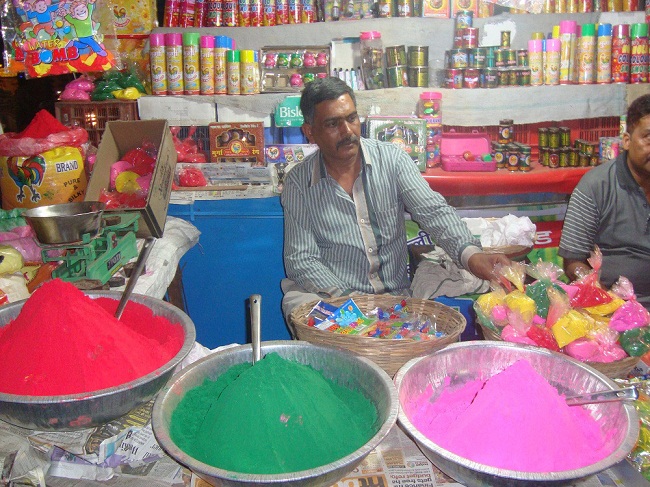
A shopkeeper, selling all the things related to the holi colors. He has decorated his shop very well in the well organized manner.
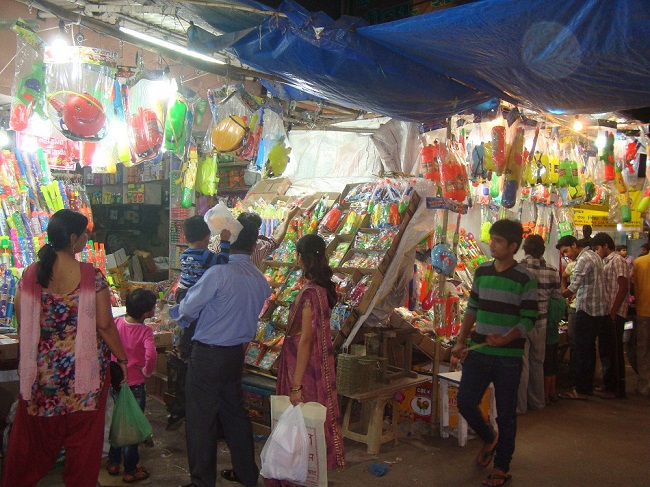
Parents and children are wandering in the market in the evening for the shopping purposes. They are shopping goods from the market for the joyful holi celebration. They are shopping for toys, abir, pichkari, colors, firecrackers and so many necessary things.
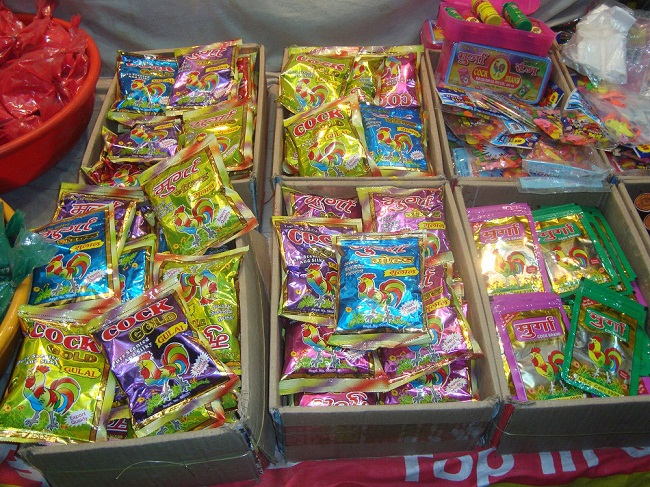 Holi colors, abir and firecrackers
Holi colors, abir and firecrackers
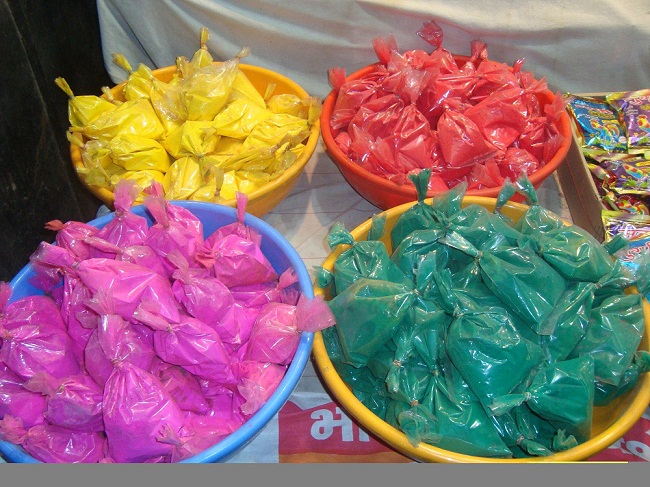
Holi colors in different shades
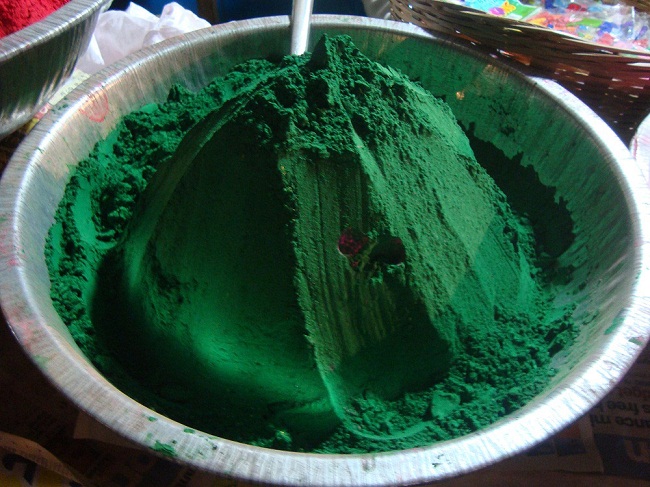 It is the picture of the green color abir available in the market. What a nice color of it. People use it on the festival of holi to get participated in the colorful event.
It is the picture of the green color abir available in the market. What a nice color of it. People use it on the festival of holi to get participated in the colorful event.
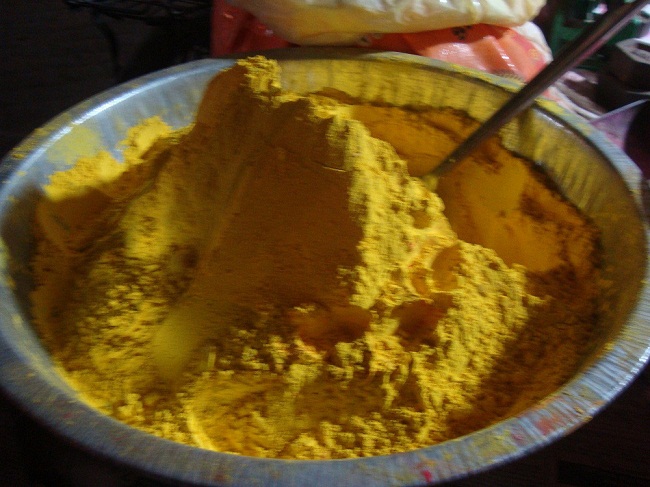
It is the picture of the yellow color abir, looking very nice and attractive. People use it at holi festival to apply it on the forehead to each other while meeting to each other in the evening ceremony.
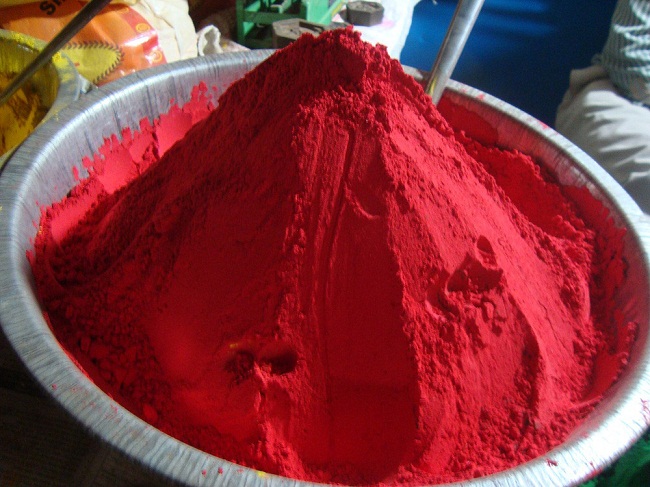
It is the picture of the red color abir, which is used at holi by most of the people to apply on the forehead while meeting. It is also used in playing the color in the morning.
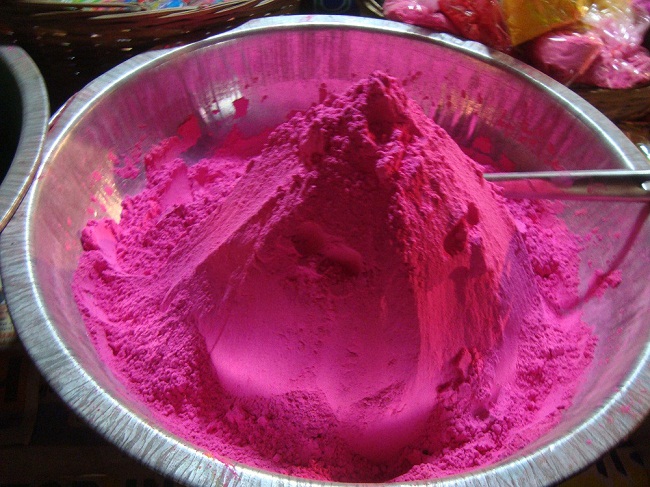
It is the picture of the pink color abir, looking very calm, peaceful and attractive. It is mostly used by the people to apply on the forehead of each other while meeting in the morning ceremony at holi.
Related Information:
